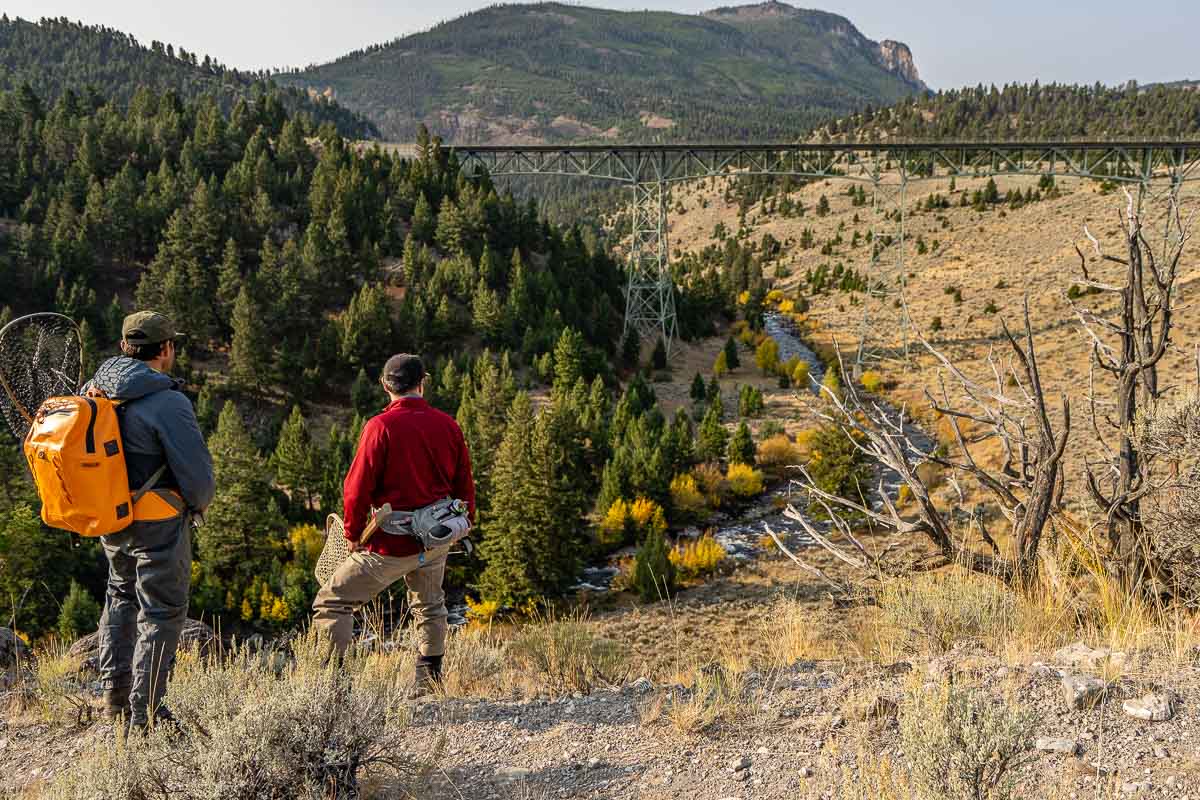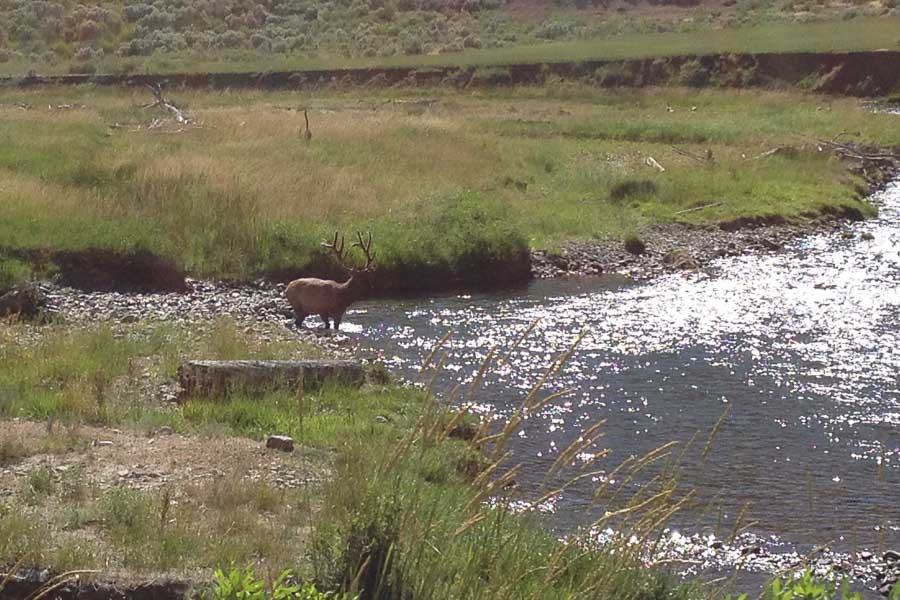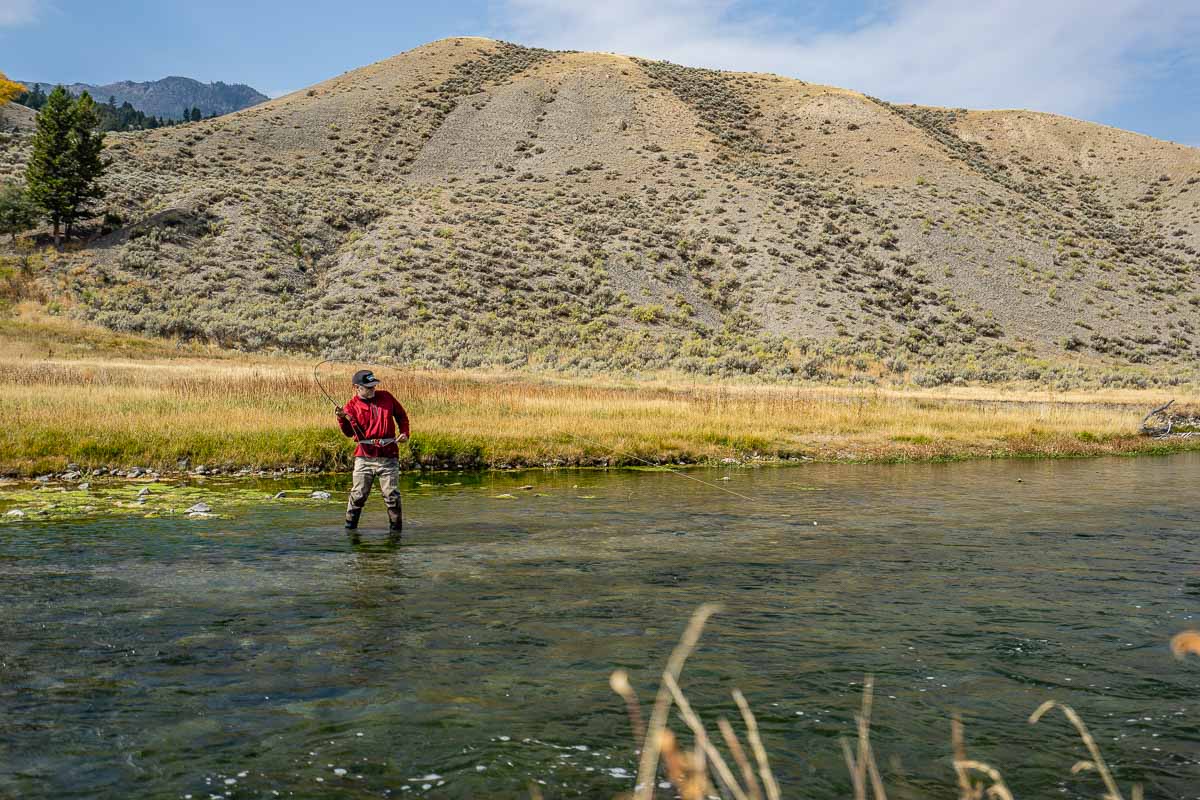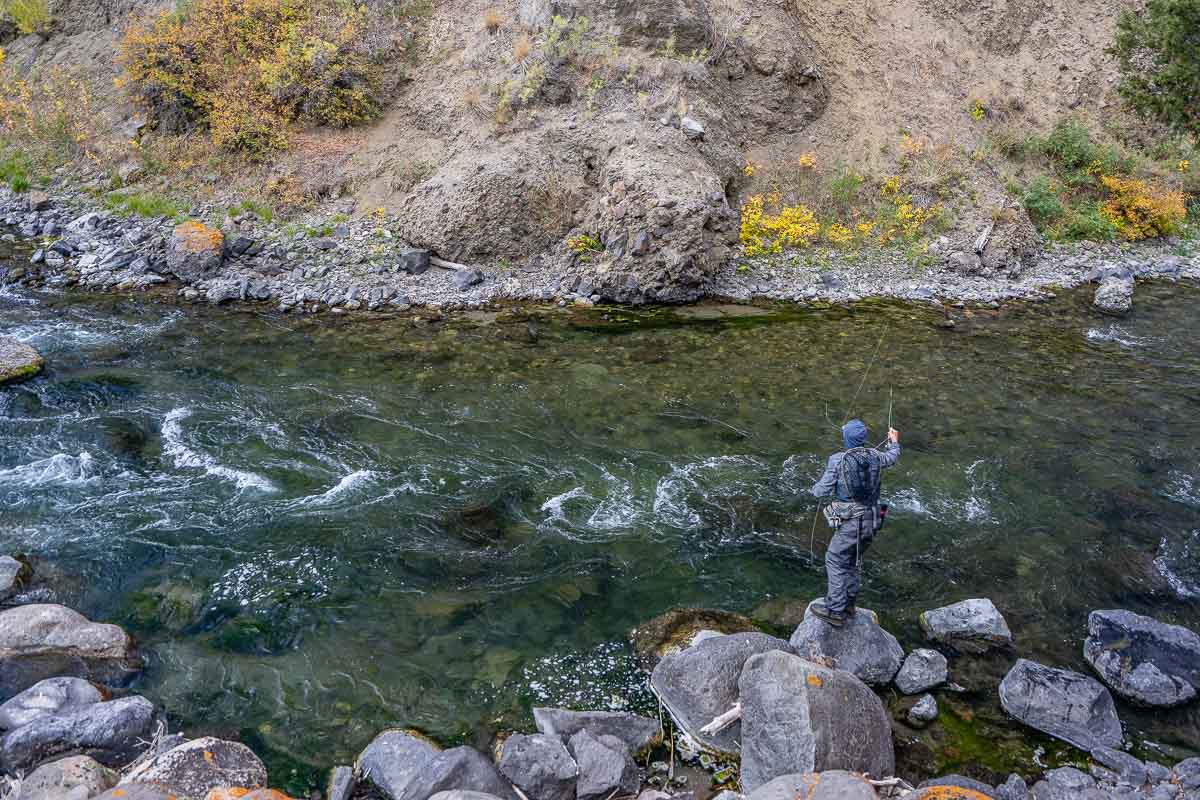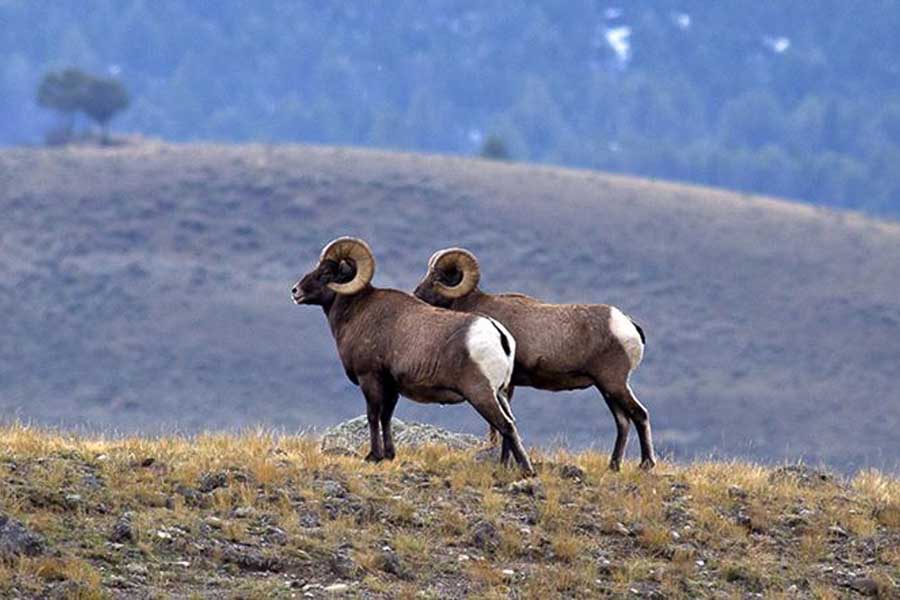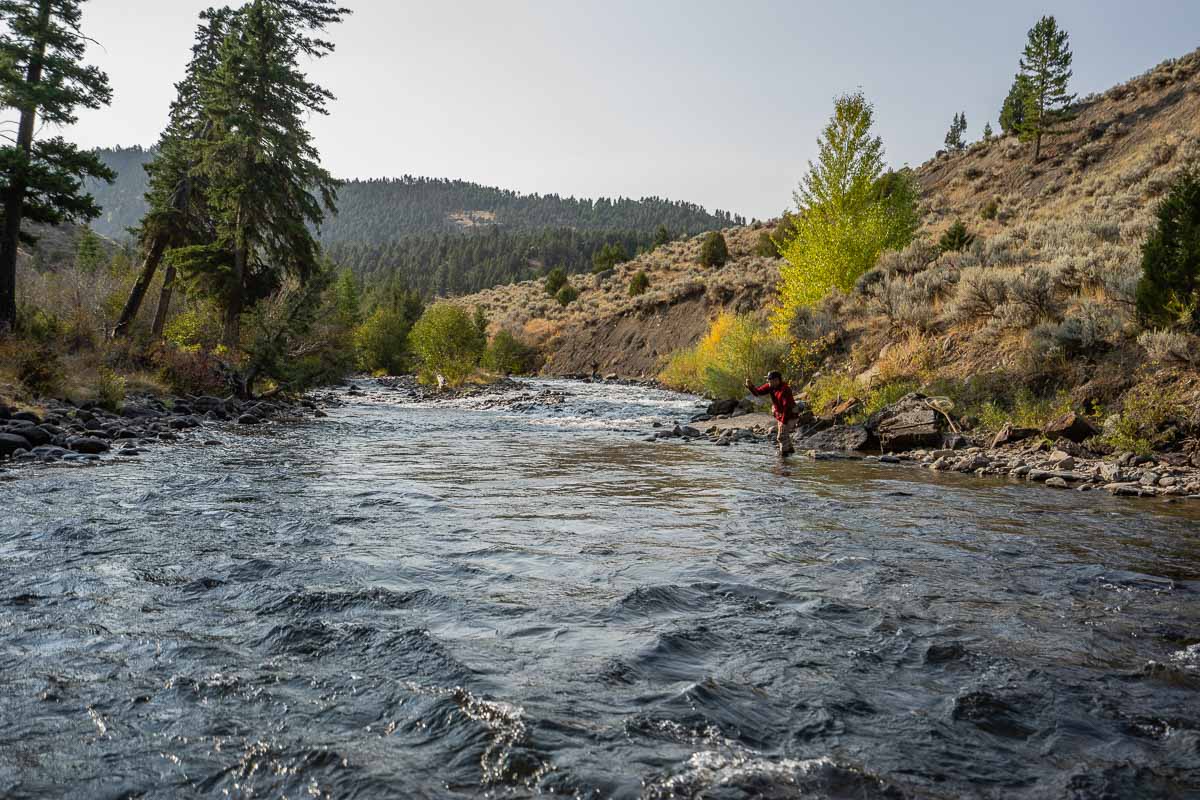A fly-fishing trip to the Gardner River takes you to a fairly small river located in the extreme northwestern corner of Yellowstone National Park. It’s headwaters are contained in a high altitude meadow, while its confluence with the Yellowstone River is surrounded by sagebrush at the lowest point in Yellowstone Park. In between, much of the Gardner rushes through canyons and rapids. Two significant features along the way are Osprey Falls and the Boiling River. Osprey Falls is a major (100 ft +) waterfall that cuts off fish populations above and below. The Boiling River pumps a large volume of 140 degree water into the river, changing its character significantly.
Fly Fishing the Gardner River Overview
The Gardner is a prototypical pocket water fishery, with many boulder gardens and few deep, slow pools. In its headwaters, above Osprey Falls, the river is populated by small Brook Trout. A big fish in this reach is 12” with most falling under 10”. Below the falls, the Gardner hosts quite the variety with Brook, Rainbow, Brown, and Cutthroat Trout present, along with Mountain Whitefish. Below Osprey Falls, the average fish is in the 8-12” range with fish in the 14-15” range starting to show up further downstream around the Boiling River. In the fall, Brown Trout from the Yellowstone make their spawning run up the Gardner, giving anglers a shot at larger fish. The Gardner has excellent nymph fishing early and late in season, with frequent hatches and good dry fly fishing in the summer months. Due to the rivers’ swift nature, precise patterns are not typically required; this is a place to fish attractors. A light, 3 or 4wt rod is nice on the upper river, while a 9ft 5wt is ideal on the lower water.
Fishing the Gardner River- Headwaters to Osprey Falls
This section of river, home to a robust population of small Brook Trout, is great for beginners or anyone looking for a high catch rate. The Mammoth-Norris road crosses this stretch of river and provides access. Above the bridge, the Gardner flows through large meadows but retains its swift character. Below, the river is more pocketwater and starts to cut its way into the canyon that defines much of its length. This section fishes well during the high summer, July and August.
Whether you choose to fish the meadow or the canyon, you will want a dry fly on the end of your line. Brook Trout feed aggressively on the surface and are not leader shy, so 3X works fine. In July, choose an attractor dry such as a PMX, Stimulator, or Royal Wulff in a #12 or #14. The same flies work in August as well, but a small hopper pattern will also be good choice.
Fishing the Gardner River - Osprey Falls to Boiling River
At Osprey Falls, the river is in a deep, rugged canyon. As one moves downstream, the canyon gradually opens, the river gradient lessens slightly, and the average size of fish increases. This section of river is a reliable producer in July, August, and September.
Salmonflys and Golden Stones begin to appear above the Boiling River during the first week of July. Nymphing stonefly patterns is the most productive method in the morning before the adult stones become active. The water is still high in early July so focus on the softer water along the banks and behind the numerous boulders in the stream. The hatch remains strong for 2 to 3 weeks and has the full attention of the fish. Due to the broken nature of the water, you will mostly be blind fishing your dries rather than casting to risers. It’s tough for you to spot risers and equally tough for the trout to turn down such a big meal.
As the big stonefly hatches wind down, caddis become the most important hatch. Evenings in late July and August bring rising fish all the way until dark. For caddis hatches, look for somewhat flatter water, especially those areas that are lined with willows. During the daytime, hopper patterns and attractors will be your bread and butter. Deep nymphing or dry-dropper combos will be very effective as well, especially first thing in the morning.
Fishing the Gardner River - Boiling River to Mouth
Due to the large thermal influence of the Boiling River, this section of the Gardner takes on a different character than the waters above. Aquatic plants are common and the gradient eases slightly. Hatches, as well as trout, are more abundant. The river here is fishable each month of the Yellowstone Park season most years. The Gardner drainage is short, steep, and lacks major tributaries, allowing the water to rise and fall rapidly. The Gardner is sleeper bet in late May thru early June. Cool temperatures can drop the river into fishable shape and put the fish on the feed. The water will still be high, so plan on high sticking stonefly nymphs in the slower water along the riverbank. Don’t count on the Gardner at this time of year, but don’t pass it up if you happen to encounter cold weather during this timeframe.
More reliable fishing on this section comes in the last 10 days of June as runoff subsides and the Golden Stones and Salmonflys begin to emerge. Nymphing will still be your go to early in the day, but be ready to pull out the dry flies when the adult bugs become active in the willows and take to the air. The river can provide up to two weeks of good stonefly fishing before the caddis take over. Your nymph rigs should feature a stonefly with a caddis dropper, while evenings bring consistent dry fly fishing over rising fish. During the midday hours, attractors and terrestrials become important as the summer warms. In August, this section of river can become too warm for fishing some summers. During cooler weather, look for hoppers by day with caddis continuing in the evenings.
As the river cools during September and October, a push of spawning fish makes their way up from the Yellowstone River. This gives the angler a shot at some Browns up to 20”, an impressive feat for such a small river. Nymphing is the prefered tactic for these fish, and will take plenty of resident fish as well. Cloudy days see exceptional hatches of Blue Winged Olives, and you will see noses greedily grabbing bugs everywhere. While the spawning fish generally eschew rising, it is hard to pass up dry fly fishing so late in the season. This section of the Gardner holds up until the very last day of the fishing season, and would fish well even later if the Park would allow it.


